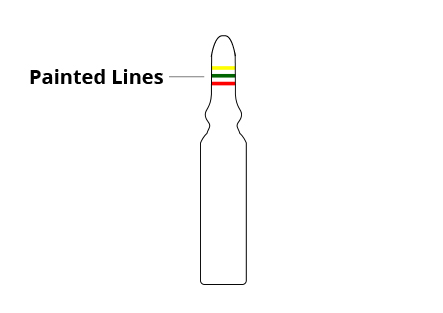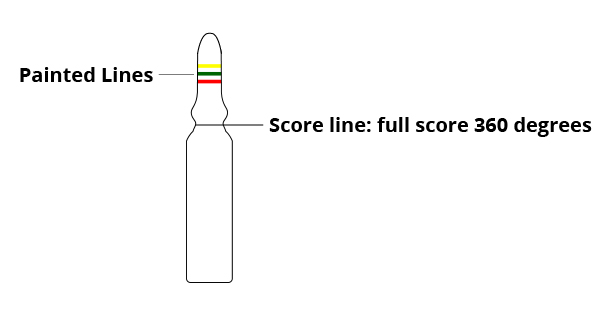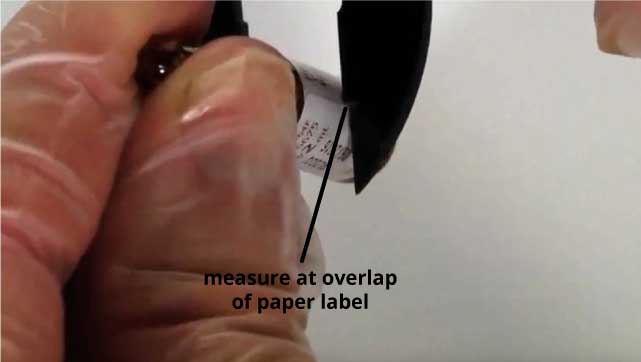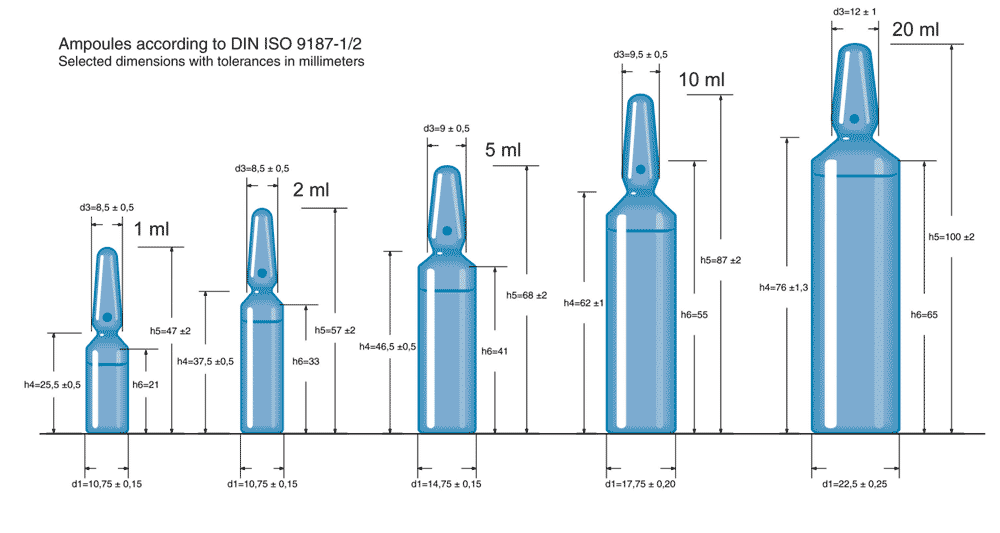Don’t know which ampoule opener to use? No problem! Measuring your ampoule is easy and will enable you to determine which ampoule opener will safely open your ampoules with consistency and ease. Don’t want to measure ampoules, just send us samples instead.
Step 1: Identifying your ampoule type. SEE short video on identifying your type of ampoule OR read on.
What type of glass ampoule do you have?
Components of glass ampoules:
Modern glass ampoules are produced industrially from short lengths of glass tubing, shaped by heating with gas torches and gravity in automated production lines.
Ampoule Diagram shows unfilled glass ampoule. The components of a glass ampoule are the base, the body of the ampoule, the shoulder (height from the base to the point shown); the narrow point called the neck, where the score line typically is; the width of the ampoule head and finally the overall height (from the base to the tip of the head of the ampoule). Upon sealing of the tip, like in the photo shown, the head/tip is closed in a smooth rounded tip. It is these measurements that are important to have to ensure which size opener you need made or is available in our present models.

Markings on glass ampoules: Ampoules often have painted rings on the neck area.
The color-coded neck rings have no significance to our purposes.
Color coding of modern ampoules is done during the manufacturing process. A machine paints colored rings on the ampoule shortly after it has been sealed. The rings are made of a substance that is readable by other machines. These color codes identify the substance inside the ampoule so that it does not need to be tested to verify the contents. The machine-readable color codes allow for accurate handling of the substance for the purposes of storage, labeling, and secondary packaging.

Note: Painted lines on head or elsewhere mean nothing, as far as type of ampoule it is, They are often present.
Specific types of ampoules:
DIN & OPC type:
Single painted dot on neck area.
DIN and OPC ampoules will have a painted dot above the neck, like in drawing above. The single dot will mean that the ampoule is a “unidirectional” opening ampoule. What that means: the neck can only be broken in one direction. Under the dot is a very small scratch in the glass, when you apply force in the direction of the dot, the glass starts to crack, this leads to a cleaner break in the glass. The ampoule will not open if you try to force the neck in the wrong direction. This usually causes the glass to shatter. The types of ampoules that have a single dot are called: DIN ISO (European standard designs) or OPC type (these are one point cut). Note: some of our openers available are for DIN ampoules, see the DIN SIZING chart if it has a dot. It is important to align the dot as instructed in our openers to open them correctly. These ampoules can have painted rings on them as well, the most important for these ampoules is the single dot.

Full Score type:
Ampoules that do not have a dot, may have painted rings on it like the photo, the rings mean nothing for our purposes, below the rings at the narrowest point in the neck there will be a scratch on the glass, this scratch will go all the way around the neck. This is a full score ampoule type. This ampoule neck can be broken in any direction. Placement of this type of ampoule in our openers needs no special alignment.

Non-scored ampoules: Some times ampoules will have no form of score on them at the neck. These ampoules cannot be broken without severe risk, unless they are scored using a small file. Contact us for instruction on method.
Labels: Glass ampoules can have painted/printed instructions directly on the glass, or a thin plastic label and or paper labels. It is important to measure the body of the ampoule allowing for the label present. Should a label overlap on the body, make sure the width is measured at the overlap point to get a correct measurement of the widest point.

You now have the information needed to identify your type of ampoule and size it.
Step 2: Measuring your ampoule:
Required measurements:
To produce an opener to suit your ampoule without samples, we’ll need the specifications of the ampoule’s to be opened. The specifications are easy to obtain from your ampoule manufacturer, or you can perform the task easily yourself after viewing our ampoule measuring instructional video, using either a metric ruler measuring in millimeters (mm), or metric micrometer.
Dimensions needed (in mm, to within +/- 0.5mm accuracy):
1. Width (diameter) of base
2. Overall height
3. Height to shoulder from base
4. Height to the score line from the base
5. Neck area measurement from score line to tip
6. The width of the head of the ampoule.
It is always wise to measure a few of the same size ampoule’s from within different batches, as dimensions can vary somewhat in production.
Important: If ampoule’s to be opened have, or will have labels affixed at the time of opening, that go around the body, the label itself must be included in measurements to accurately account for fit within the opener.
If pharmacy is attaching identification labels on the neck or body of the ampoule, separate to the label already on the ampoule, please inform us of this.
You now have all the information required to forward to us to have a opener made for your ampoule (contact us) or to search through our models to make a selection. Home page.
Step 3: If you have identified your ampoule as a DIN or OPC type, check the sizing at DIN SIZING chart, below.
a). Compare your measurements from step 1 and 2 with the DIN SIZING chart below. If your ampoule matches the sizing you can proceed to ordering an opener from either: AO DIN SIZES 1, 2, & 5 ml or our premium opener system AOP DIN SIZING.
b). If your ampoule is outside the measurements shown and is still a DIN or OPC type, then GO to AOP DIN SIZING and find the corresponding DIN size for your ampoule’s.
Step 4: Non DIN ampoules.
a). If your ampoule is not a DIN type, then proceed to AOP AMPOULE LIBRARY and search our library for your type and size of ampoule, or go to AOP CUSTOM SIZING or AOT CUSTOM SIZING.
b). Confident of your measurements and cannot find your ampoule in our library.
Simply go to CUSTOM ORDERS and give us your measurements and we will make you an opener of your choice in either AOT or AOP design to match your ampoule.
Step 5: Custom openers for ampoules of any size.
Need to order a custom opener for your sized ampoule.
- Our prefered means of making you a custom opener system is having actual samples of your ampoules to measure and test before we ship the unit to you. This saves a great deal of time and ensures that your opener works perfectly. We require a minimum of 2-6 ampoules of each type shipped to our SHIPPING ADDRESS. Note: Your shipping fees will be refunded from your first order. Plus a 25 % discount on your follow on order.
- Or at minimum. Accurate measurements of your ampoule/s per our instructions: MEASURING YOUR AMPOULE/S. and
- Photos of your ampoule/s.
And OR
- The manufacturer specifications of the ampoule/s.
This information plus any special design needs and procedural requirement/s can be supplied through our CUSTOM ORDERING form via email. Please indicate which type of opener you are seeking in either: AOP or AOT designs.
